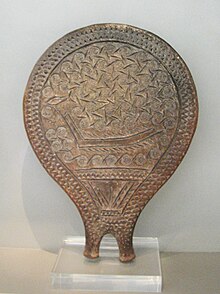
The Cyclades are an island group in the Aegean Sea, southeast of mainland Greece and a former administrative prefecture of Greece. They are one of the island groups which constitute the Aegean archipelago. The name refers to the archipelago forming a circle around the sacred island of Delos. The largest island of the Cyclades is Naxos, however the most populated is Syros.
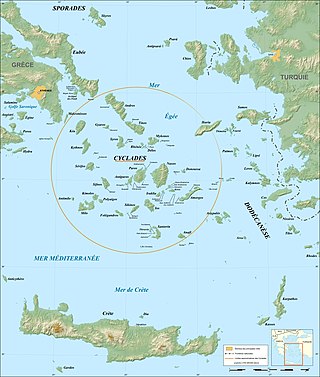
Cycladic culture was a Bronze Age culture found throughout the islands of the Cyclades in the Aegean Sea. In chronological terms, it is a relative dating system for artifacts which serves as a roughly contemporary dating system to Helladic chronology and Minoan chronology (Crete) during the same period of time.

Ekron, in the Hellenistic period known as Accaron was a Philistine city, one of the five cities of the Philistine Pentapolis, located in present-day Israel.
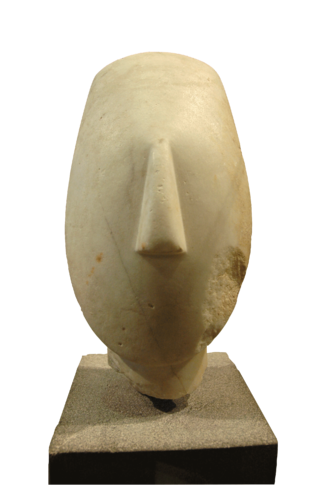
Aegean art is art that was created in the lands surrounding, and the islands within, the Aegean Sea during the Bronze Age, that is, until the 11th century BC, before Ancient Greek art. Because is it mostly found in the territory of modern Greece, it is sometimes called Greek Bronze Age art, though it includes not just the art of the Mycenaean Greeks, but also that of the non-Greek Cycladic and Minoan cultures, which converged over time.

Minoan pottery has been used as a tool for dating the mute Minoan civilization. Its restless sequence of quirky maturing artistic styles reveals something of Minoan patrons' pleasure in novelty while they assist archaeologists in assigning relative dates to the strata of their sites. Pots that contained oils and ointments, exported from 18th century BC Crete, have been found at sites through the Aegean islands and mainland Greece, on Cyprus, along coastal Syria and in Egypt, showing the wide trading contacts of the Minoans.

Keros is an uninhabited and unpopulated Greek island in the Cyclades about 10 km (6 mi) southeast of Naxos. Administratively it is part of the community of Koufonisia. It has an area of 15 km2 (6 sq mi) and its highest point is 432 m (1,417 ft). It was an important site to the Cycladic civilization that flourished around 2500 BC. It is now forbidden to land in Keros.

The ancient Cycladic culture flourished in the islands of the Aegean Sea from c. 3300 to 1100 BCE. Along with the Minoan civilization and Mycenaean Greece, the Cycladic people are counted among the three major Aegean cultures. Cycladic art therefore comprises one of the three main branches of Aegean art.
A frying pan is a pan used for cooking, also known as a skillet. Frying pan may also refer to:

Akrotiri is the site of a Cycladic Bronze Age settlement on the volcanic Greek island of Santorini (Thera). The name comes from the nearby village of Akrotiri.
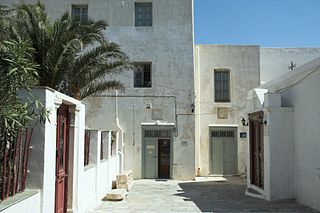
Archaeological Museum of Naxos is a museum in Naxos Greece.

Phylakopi, located at the northern coast of the island of Milos, is one of the most important Bronze Age settlements in the Aegean and especially in the Cyclades. The importance of Phylakopi is in its continuity throughout the Bronze Age and because of this, it is the type-site for the investigation of several chronological periods of the Aegean Bronze Age.
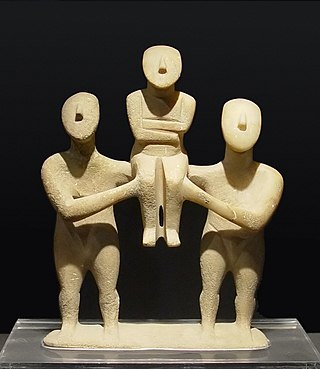
The Keros-Syros culture is named after two islands in the Cyclades: Keros and Syros. This culture flourished during the Early Cycladic II period of the Cycladic civilization. The trade relations of this culture spread far and wide from the Greek mainland to Crete and Asia Minor.
The Cycladic frying pan is a ceramic item from the Bronze Age Cycladic civilization. It dates to the early Cycladic period, between the 28th and 23 centuries BC. The frying pan derives from grave 74 of Chalandriani cemetery on the Cycladian island of Syros. It was discovered in 1889/90 during excavations led by Christos Tsountas, along with other pottery and was first published by Tsountas in 1899. With the inventory number 4974, the frying pan is now kept in the National Archaeological Museum of Athens. The purpose of the frying pan is unknown.
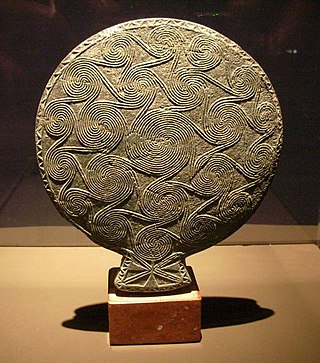
The Cycladian frying pan is an ornately decorated stone object of the type nicknamed as frying pans, from the Bronze Age Cycladic civilization. It dates to the Early Cycladic period, between the 27th and 24th centuries BC. The find spot is unknown, except that it originated on the Cycladic island of Naxos. The item derived from an illegal excavation and was acquired in 1975 by the Badisches Landesmuseum in Karlsruhe. On 6 June 2014 it was repatriated to the National Archaeological Museum of Athens, Greece.
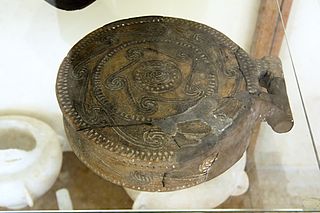
The Cycladic Frying pan is a ceramic object from the Bronze Age Cycladic culture of the Kampos type. The frying pan of the Early Cycladic period derives from grave 3 of the small cemetery of Kampos on the Cycladic island of Paros. It was discovered alone in autumn 1924 in the excavations led by Irini Varoucha and was first published in 1926. It is displayed in the Archaeological Museum of Paros with the inventory number 2136. The purpose of Cycladic frying pans is not known.
The Lesser Cyclades or Small Cyclades is an island complex in the Aegean Sea, inside the archipelago of the Cyclades. It is located to the south-east of Naxos and comprises 32 islands and rocks. The main islands are Ano Koufonisi, Kato Koufonisi, Irakleia, Schoinoussa, Donousa and Keros. The largest of them is Irakleia with an area of 18 km2 and the most populated is Ano Koufonisi with a population of 399, according to the 2011 census. Only four of them are inhabited, Ano Koufonisi, Irakleia, Donousa and Schoinoussa. The islet of Kato Antikeri has also two inhabitants. Administratively, the islands belong to the Naxos and Lesser Cyclades municipality apart from the islets of Ano and Kato Antikeri that belong to Amorgos municipality.

The Grotta-Pelos culture (Greek: Γρόττα-Πηλός) refers to a "cultural" dating system used for part of the early Bronze Age in Greece. Specifically, it is the period that marks the beginning of the so-called Cycladic culture and spans the Neolithic period in the late 4th millennium BC (ca. 3300 BC), continuing in the Bronze Age to about 2700 BC. The term was coined by Colin Renfrew, who named it after the sites of Grotta and Pelos on the Cycladic islands of Naxos and Milos, respectively. Other archaeologists prefer a "chronological" dating system and refer to this period as the Early Cycladic I (ECI).
The Kastri culture refers to a "cultural" dating system used for the Cycladic culture that flourished during the early Bronze Age in Greece. It spans the period ca. 2500–2200 BC and was named by Colin Renfrew, after the fortified settlement of Kastri near Chalandriani on the Cycladic island of Syros. In Renfrew's system, Kastri culture follows the Keros-Syros culture. However, some archaeologists believe that the Keros-Syros and Kastri cultures belong to the same phase. Others describe this period as the Early Cycladic III (ECIII).

The Phylakopi I culture refers to a "cultural" dating system used for the Cycladic culture that flourished during the early Bronze Age in Greece. It spans the period ca. 2300-2000 BC and was named by Colin Renfrew, after the settlement of Phylakopi on the Cycladic island of Milos. Other archaeologists describe this period as the Early Cycladic III (ECIII).

Saliagos is an islet in the Greek island group of Cyclades. It is the first early farming site and one of the oldest settlements of the Cycladic culture.


